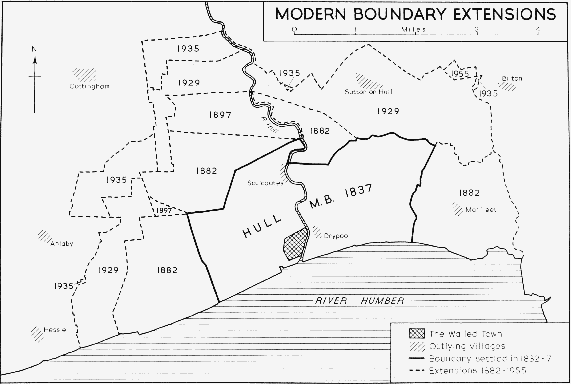
One of the most dramatic features of the landscape history of Britain in modern times has been the physical expansion of urban areas with the concomitant loss of once rural areas and of once independent or suburban communities. The map above, copied from page 9 of the Victoria County History, East Yorkshire, Vol. 1, Kingston-upon-Hull, shows the physical expansion of Hull across the last two centuries, the area of the town when constrained within the medieval town walls (until the 1760s) shown by the shaded area. In Barton on Humber the physical extent of the town was constrained within the town’s ramparts (the Castledykes) until linear development along Westfield and West Acridge Roads plus the industrialisation of the Humber floodplain, while Beverley was also constrained within its ramparts (including their four or five stone-built gates with only North Bar surviving) prior to the gentrification of North Bar Without and Beckside industrialisation.
The stages of urban expansion are often similar between communities nationwide although the timing of the stages varies between communities. One early stage in the process is ‘ribbon development’, whereby the headlands of fields adjoining arterial roads were sold-off for housing. Ribbon development housing was usually built to appeal to households with personal means of transport as it would usually be some time before public transport systems were extended. A subsequent stage was ‘back-filling’ when the rest of these fields, and fields beyond probably, were sold for building by which time a public transport system had usually been extended to the locality. Such housing areas were likely to be more dense than the ribbon housing, cheaper in value and, over time, would lead to the better off households fleeing further afield.
Another feature of Urban expansion was the implanting of large urban communities on the edge of existing urban areas; the determinants here being cheaper land prices and availability of land, the two being inter-dependent. Often in the 20th century these were from day-one working class communities so that life in the new homes was immediately undermined by poor rapid transport systems and poor infrastructure.
Some factors that underpin urban expansion today are, THE MARKET(?), the economic cycle, government incentive funding for house purchase, conservation areas and listed buildings, land availability, building technology, availability of building materials, a suitable labour force, enforcement of building standards, a balance between tenant’s and landlords right’s (the rise of ‘buy to rent’ general public landlords being a pernicious development) and population trends.
Here endeth the current topic comprised of 42 blogs.